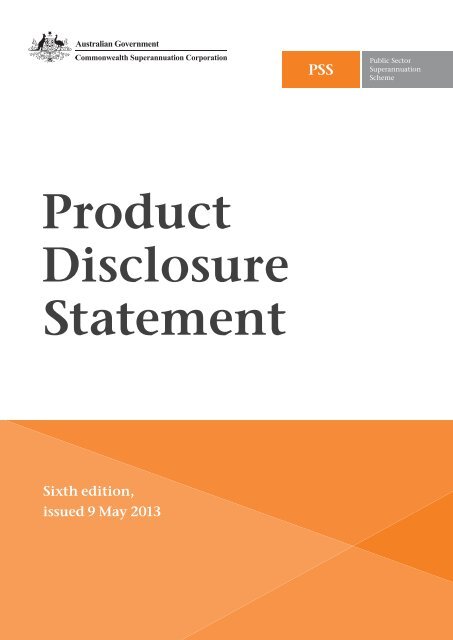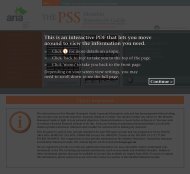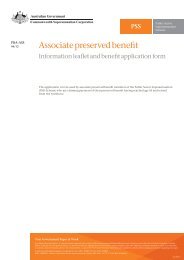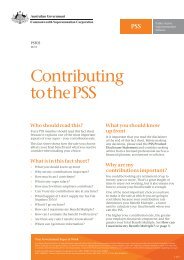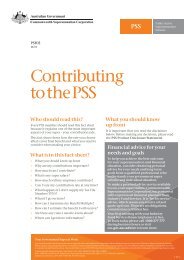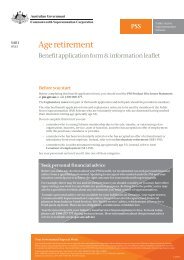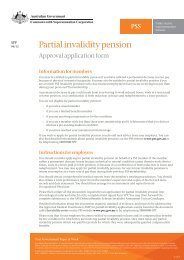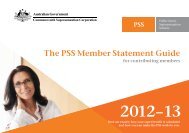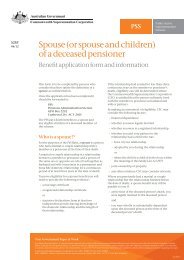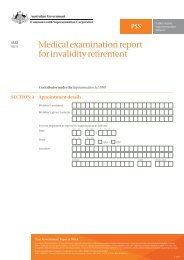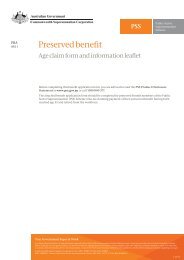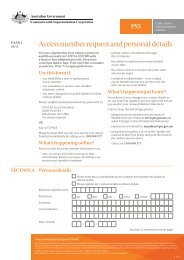Product Disclosure Statement - PSS
Product Disclosure Statement - PSS
Product Disclosure Statement - PSS
You also want an ePaper? Increase the reach of your titles
YUMPU automatically turns print PDFs into web optimized ePapers that Google loves.
<strong>Product</strong><br />
<strong>Disclosure</strong><br />
<strong>Statement</strong><br />
Sixth edition,<br />
issued 9 May 2013
Contents<br />
1. About the <strong>PSS</strong>...............................................2<br />
2. How super works .........................................3<br />
3. Benefits of investing with the <strong>PSS</strong>................3<br />
4. Risks of super...............................................4<br />
5. How we invest your money..........................5<br />
6. Fees and costs...............................................6<br />
7. How super is taxed.......................................7<br />
8. Insurance in your super...............................7<br />
9. How to open an account..............................8<br />
Contact us<br />
If you would like us to send you a copy of<br />
this PDS or any additional information<br />
referred to, or if you have any questions<br />
about the content or the <strong>PSS</strong>, call us on<br />
1300 000 377 or contact us using the details<br />
located at the back of this publication.<br />
Important note about this PDS<br />
This PDS is a summary of significant information<br />
and contains a number of references to important<br />
information. Information referred to in a coloured<br />
box marked with forms part of the PDS. Other<br />
information referred to does not form part of this<br />
PDS. You should consider that information before<br />
making a decision about the <strong>PSS</strong>.<br />
Any information in this document is general<br />
information only and does not take account of your<br />
personal financial situation or needs. You should<br />
obtain financial advice tailored to your<br />
personal circumstances.<br />
Information in this document may change from<br />
time to time. Information that is not materially<br />
adverse to you may be updated on our website,<br />
www.pss.gov.au, or contact us for a free paper copy.<br />
The offer to which this document relates is available<br />
only to persons eligible to become a member of<br />
the <strong>PSS</strong> under the Superannuation Act 1990,<br />
receiving this document (electronically or<br />
otherwise) in Australia.<br />
1. About the <strong>PSS</strong><br />
The <strong>PSS</strong> (the fund) was established under the<br />
Superannuation Act 1990, exclusively for employees of<br />
the Australian Government and other participating<br />
employers. Membership of the <strong>PSS</strong> (ABN 74 172 177 893,<br />
RSE R1004595) closed to new members from 1 July 2005.<br />
However, if you are a <strong>PSS</strong> preserved benefit member<br />
or <strong>PSS</strong> invalidity pensioner and you return to eligible<br />
employment you may be able to rejoin the <strong>PSS</strong> as a<br />
contributing member.<br />
The <strong>PSS</strong> is a defined benefit super fund, with an<br />
accumulation component for any members with<br />
transferred amounts and/or super co-contributions.<br />
The principal benefit available to contributing<br />
members is defined by their Final Average Salary and<br />
Accrued Benefit Multiple. Preserved benefit members<br />
and associate members are in an accumulation phase<br />
(component) where funded parts of super benefits are<br />
impacted by fund performance. Former spouses or<br />
partners of <strong>PSS</strong> members may become associate benefit<br />
members as the result of a family law split.<br />
In addition to your <strong>PSS</strong> retirement benefit, which can<br />
generally be taken as a lump sum and/or a pension, the<br />
<strong>PSS</strong> offers partial invalidity, permanent invalidity and<br />
death cover at no extra cost. See sections 3 and 8 for<br />
more details.<br />
About Commonwealth<br />
Superannuation Corporation (CSC)<br />
The <strong>PSS</strong> is managed by CSC (ABN 48 882 817 243,<br />
AFSL 238069, RSEL L0001397). CSC is licensed under<br />
the Corporations Act 2001 and the Superannuation Industry<br />
(Supervision) Act 1993, and is the Trustee of four regulated<br />
superannuation schemes: the <strong>PSS</strong>, the Commonwealth<br />
Superannuation Scheme (CSS), the Public Sector<br />
Superannuation accumulation plan (<strong>PSS</strong>ap), the Military<br />
Superannuation and Benefits Scheme (MilitarySuper)<br />
and administers the five unregulated/exempt public<br />
sector schemes. With over 30 years experience, CSC is<br />
responsible for all aspects of the <strong>PSS</strong>, including investment<br />
strategy, administration and member communications.<br />
For more information visit www.csc.gov.au.<br />
2 of 8<br />
Your Government Super at Work
2. How super works<br />
Superannuation (super) is a long-term way to contribute<br />
for your retirement which is, in part, compulsory and<br />
most people have the right to choose into which fund<br />
their employer should direct their superannuation<br />
guarantee contributions.<br />
Putting money into your super<br />
Only contributing members can put money into their<br />
super or receive employer contributions. The benefit<br />
provided to contributing members of the <strong>PSS</strong> is defined by<br />
the Final Average Salary and an Accrued Benefit Multiple.<br />
In the <strong>PSS</strong> your employer makes contributions in two<br />
different ways:<br />
1. a fortnightly contribution—the productivity<br />
component, and<br />
2. an employer component that is calculated when you<br />
leave the <strong>PSS</strong>.<br />
Contributing members can choose to make no<br />
contributions or to contribute any whole percentage rate<br />
between 2% and 10% of their fortnightly ‘super salary’.<br />
Contribution rates can be changed at any time to suit<br />
your financial needs.<br />
The amount you contribute affects your benefit. If you<br />
elect to make no contributions your employer-financed<br />
component will accrue at a reduced rate during the<br />
period you are not contributing. As a result, this will<br />
reduce any future benefits that might be payable.<br />
Member contributions, post 1 July 1990 productivity<br />
contributions, amounts transferred to the <strong>PSS</strong> and any super<br />
co-contributions are affected by investment performance.<br />
However, investment performance does not affect a<br />
contributing member’s defined benefit. It can however,<br />
affect any transfer amounts or co-contribution amounts.<br />
There are limitations on the contributions you can make<br />
to your super. You may, depending on your income, also<br />
be entitled to government co-contributions.<br />
For more information refer to our website and the<br />
various fact sheets available including Contributing<br />
to the <strong>PSS</strong>, <strong>PSS</strong> super co-contribution and Maximum<br />
benefit limits. You are encouraged to refer to this<br />
information as it is an important component of your<br />
benefit and can be complex.<br />
Withdrawing your super<br />
There are limitations on making withdrawals from your<br />
super and what form you can withdraw it in (a pension,<br />
lump sum or a combination of these). In most cases, you<br />
can only withdraw your super after reaching minimum<br />
retirement age (55) and retiring permanently from the<br />
workforce. However, you may be able to access your<br />
super or some component of it earlier in some cases.<br />
For more information refer to the various facts sheets and<br />
information available on our website that cover issues<br />
such as age retirement, preservation of benefits and early<br />
access to superannuation benefits.<br />
Super and tax<br />
The Government provides tax savings in relation to<br />
superannuation. For more information, go to section 7.<br />
3. Benefits of investing<br />
with the <strong>PSS</strong><br />
Competitive costs<br />
Employers contribute toward the costs of administering<br />
the <strong>PSS</strong>, which helps reduce the cost to you. The <strong>PSS</strong><br />
pays no commissions to financial advisers. There are,<br />
however, some fees and charges. For more information,<br />
go to section 6.<br />
Investment choice<br />
We offer two investment options that are available to<br />
preserved and associate members. They can choose<br />
from the Default Fund or the Cash Investment Option.<br />
There is no choice of investment option for contributing<br />
members. For more information, go to section 5.<br />
Invalidity and death cover<br />
The <strong>PSS</strong> offers partial invalidity, permanent invalidity<br />
and death cover at no extra cost. Additional death<br />
and invalidity cover is also available for contributing<br />
members who are unable to reach their maximum<br />
benefits limit (MBL) at a relatively low cost. For more<br />
information, go to section 8.<br />
Information<br />
Our member communications program brings<br />
information to you at your place of work with<br />
educational workshops, email updates and online<br />
services at your fingertips. You can reach us when you<br />
need to by email, phone, fax and letter, whichever is<br />
most convenient for you.<br />
Understanding your employment conditions<br />
We work closely with employers for the benefit of<br />
members. Our organisation has extensive experience in<br />
providing superannuation services to employees of the<br />
Australian Government and participating employers.<br />
Financial advice<br />
CSC has partnered with experienced financial planners<br />
from Industry Fund Services to bring a personal financial<br />
advice service to you. It is ‘fee for service’ advice, which<br />
means you receive a fixed quote up front. There are<br />
no obligations, commissions or hidden fees. Your first<br />
meeting with your Industry Fund Services financial<br />
planner is free. To arrange this initial advice appointment<br />
please call 1300 277 777 during business hours.<br />
For more information about the features and benefits of<br />
the <strong>PSS</strong> go to www.pss.gov.au.<br />
Your Government Super at Work 3 of 8
The <strong>PSS</strong> is a defined benefits scheme. Unlike more common accumulation funds, the <strong>PSS</strong> provides you with a<br />
benefit that is ‘defined’ by your Final Average Salary and an Accrued Benefit Multiple (which depends, in part,<br />
on your rate of contributions to the <strong>PSS</strong>). These two factors have a greater influence on a contributing member’s<br />
benefit than investment returns.<br />
Final Average Salary × Accrued Benefit Multiple = Your Benefit<br />
<strong>PSS</strong> benefits, can, depending on the circumstances, be taken as a lump sum, pension or a combination of both.<br />
If you have become a member as a result of a Family Court splitting order, your benefit is calculated differently.<br />
For more information see the Family law and super splitting - how this is done and what happens next<br />
booklet available on our website.<br />
4. Risks of super<br />
Super, like any investment, has risks. The opportunity<br />
to choose how you invest your super in the <strong>PSS</strong> carries<br />
with it a responsibility to make well-informed decisions<br />
suitable to your personal objectives, financial situation<br />
and needs. The level of risk appropriate for each person<br />
will vary depending on a range of factors, including, but<br />
not limited to, age, investment time frames, risk tolerance<br />
and other investments.<br />
The accumulation component, like any investment, has<br />
risks. There are significant risks which may affect the<br />
accumulation component—see the table below. Each<br />
investment option has a different risk level. Assets with<br />
the highest long-term expected returns may also carry<br />
the highest level of short-term risk. Different options may<br />
carry different levels of risk, depending on the assets that<br />
make up the option.<br />
Risk can be managed and even minimised, but cannot be<br />
eliminated. The value of investments will vary. No matter<br />
how skilled the investment manager, or how strong<br />
performance has been in the past, the level of returns<br />
will vary, and future returns may differ from past returns.<br />
Returns applying to your accumulation component are<br />
not guaranteed and there is always a chance you could<br />
receive less than you invested. The amount of your<br />
superannuation benefit (including contributions and<br />
returns on your accumulation component) may not be<br />
enough to provide adequately for your retirement.<br />
Further information about the risks of the <strong>PSS</strong><br />
(including the investment options) is available on<br />
our website. You should read the important<br />
information about risk before making a decision.<br />
Go to the Investment Options and Risk booklet<br />
available at www.pss.gov.au/pds. The material<br />
relating to risk may change between the time<br />
when you read this <strong>Statement</strong> and the day when<br />
you acquire the product.<br />
Risk<br />
Inflation<br />
Asset investment<br />
risk<br />
Market risk<br />
Interest rate risk<br />
Currency risk<br />
Derivatives risk<br />
Fund risk<br />
Liquidity risk<br />
Insurance risk<br />
Super laws*<br />
Changes to tax*<br />
Description<br />
Inflation may exceed the return on investment.<br />
Individual assets we buy can (and do) fall in value for many reasons, such as changes in<br />
the internal operations or management of a fund or company we invest in, or in its<br />
business environment.<br />
Economic, technological, political or legal conditions, and even market sentiment,<br />
can (and do) change, and this can affect the value of the investments in the fund.<br />
Changes in interest rates can have a positive or negative impact directly or indirectly on<br />
investment value or returns.<br />
We invest in other countries and if their currencies change in value relative to the Australian<br />
dollar, the value of the investment can change.<br />
We may use derivatives to reduce risk or gain exposure to investment markets when we think it<br />
appropriate. Risks associated with these derivatives include the value of the derivative failing<br />
to move in line with the underlying asset, market or index, and counterparty risk—the risk that<br />
the other party to the derivative contract cannot meet its obligations under the contract.<br />
Risks particular to the fund include that it could cease operation, that fraud against CSC could<br />
occur, Board restructure and our investment professionals could change.<br />
Assets that we invest in can become difficult to trade under certain market conditions.<br />
Additional death and invalidity cover is obtained from a third party. There are risks that the<br />
additional death and invalidity cover does not meet your individual needs. You should read<br />
this PDS and the Additional death and invalidity cover booklet available on our website to<br />
ensure that you are eligible and that the cover is right for you.<br />
Changes are frequently made to superannuation law and may affect your benefit and your<br />
ability to access it. For example, under the existing law, your super benefit may be split by<br />
agreement or by court order if you and your spouse permanently separate.<br />
Changes can occur to taxes on investments or super generally, which may affect the value of<br />
your investment or benefit.<br />
* These risks also apply to the defined benefit component of the <strong>PSS</strong>.<br />
4 of 8<br />
Your Government Super at Work
5. How we invest<br />
your money<br />
Preserved and associate members have the<br />
option of investing in either the Default Fund or<br />
Cash Investment Option. There is no investment<br />
choice for contributing members. Contributing<br />
members have their accumulation component<br />
(i.e. member contributions, productivity contributions,<br />
transfer amounts and co-contributions) invested in<br />
the Default Fund.<br />
When choosing an investment option you<br />
must consider:<br />
> > the amount of time your money will be invested<br />
before you need it for retirement<br />
> > the likely investment performance<br />
> > the level of risk and fluctuation in the value of<br />
your investment that you can tolerate.<br />
Default Fund<br />
Preserved and associate members that do not choose<br />
an investment option will have their super invested in<br />
our default option called the Default Fund. This is a<br />
‘pre-mixed’ investment option, investing across a range of<br />
asset classes, and having a medium- to high-level of risk.<br />
The objective of the Default Fund is to outperform the<br />
consumer price index (CPI) by 3.5% per annum over the<br />
medium- to long-term.<br />
The Default Fund is designed to invest in different types<br />
of investments that tend to perform independently of<br />
each other. By diversifying in this way, the Default Fund<br />
reduces its reliance on equity market returns and aims to<br />
provide a smoother pattern of long-term returns.<br />
This investment option is intended for those investors<br />
prepared to take more risk in exchange for potentially<br />
higher returns on their investment over the medium- to<br />
long-term, and willing to accept moderate- to higherlevels<br />
of volatility and periods of negative returns.<br />
Such investors tend to have a medium- to long-term<br />
investment horizon. The minimum suggested timeframe<br />
for holding this option is ten (10) years.<br />
The following table sets out the type of assets that make<br />
up the Default Fund, and their target allocations.<br />
Investment<br />
Corporate<br />
assets<br />
Real assets<br />
Sovereign<br />
assets<br />
Alternative<br />
strategies<br />
Australian and international<br />
shares, private equity and<br />
corporate credit<br />
Private and public property,<br />
infrastructure and other<br />
real assets<br />
Target<br />
62%<br />
15%<br />
Government bonds and cash 9%<br />
Multi-asset strategies 14%<br />
The following table sets out the permitted range of<br />
asset allocations.<br />
Target asset allocation range*<br />
Corporate<br />
assets<br />
Real assets<br />
Sovereign<br />
assets<br />
Alternative<br />
strategies<br />
Australian and international<br />
shares, private equity and<br />
corporate credit<br />
Private and public property,<br />
infrastructure and other<br />
real assets<br />
30-75%<br />
5-25%<br />
Government bonds and cash 5-65%<br />
Multi-asset strategies 0-30%<br />
* Target exposures to private assets (private equity, private<br />
debt and real assets) are limited to around 25% of the fund,<br />
with a rebalancing range of ± 10% around that target.<br />
You should read the important information about<br />
both of our investment options before making a<br />
decision. Go to the Investment Options and Risk<br />
booklet available at www.pss.gov.au/pds. The<br />
material relating to investment options may change<br />
between the time when you read this <strong>Statement</strong> and<br />
the day when you acquire the product.<br />
Your Government Super at Work 5 of 8
6. Fees and costs<br />
Did you know<br />
Small differences in both investment performance<br />
and fees and costs can have a substantial impact on<br />
your long-term returns.<br />
For example, total annual fees and costs of 2% of<br />
your fund balance rather than 1% could reduce<br />
your return by up to 20% over a 30-year period<br />
(for example, reduce it from $100,000 to $80,000).<br />
You should consider whether features such as<br />
superior investment performance or the provision of<br />
better member services justify higher fees and costs.<br />
You may be able to negotiate to pay lower contribution<br />
fees and management costs where applicable.* Ask the<br />
fund or your financial adviser.<br />
To find out more<br />
If you would like to find out more, or see the impact<br />
of the fees based on your own circumstances, the<br />
Australian Securities and Investments Commission<br />
(ASIC) website (www.moneysmart.gov.au) has a<br />
superannuation calculator to help you check out<br />
different fee options.<br />
* We are required by law to provide you with the above<br />
information. As you are not charged contribution fees for<br />
the <strong>PSS</strong> and the only management costs are the investment<br />
management costs recovered from the fund as a whole, you<br />
cannot negotiate contribution fees and management costs<br />
with the <strong>PSS</strong>. The calculator on the ASIC website can be used<br />
to calculate the effect of fees and costs on account balances.<br />
Fees and costs of the Default Fund<br />
The main fees and costs involved in investing in the<br />
Default Fund are set out in the following table:<br />
Type of fee or cost<br />
Amount<br />
Example of annual fees and costs<br />
for the Default Fund<br />
This table gives an example of how the fees and costs in<br />
the Default Fund investment option can affect your super<br />
investment over a one (1) year period. You should use this<br />
table to compare this product with other superannuation<br />
products you may be considering.<br />
Example – Default Fund<br />
(a balanced investment<br />
option)<br />
Contribution<br />
fees<br />
Plus<br />
management<br />
costs<br />
Equals<br />
cost of the fund<br />
Nil<br />
Balance of $50,000 with<br />
total contributions of $5,000<br />
during the year<br />
For every $5,000 you put in,<br />
you will be charged $0<br />
0.80% And, for every $50,000 you<br />
have in the fund you will be<br />
charged $400 each year<br />
If you put in $5,000 during<br />
a year and your balance was<br />
$50,000, then for that year<br />
you will be charged fees of:<br />
$400*<br />
What it costs you will<br />
depend on the investment<br />
option you choose.<br />
* Please note that this is a notional amount only. This<br />
amount is not deducted from, nor does it have any effect<br />
on the value of, your account or benefit while you are<br />
a contributing member. As your benefit is a defined<br />
benefit, and is not impacted by Fund earnings, the Fund’s<br />
management costs do not affect the amount of your<br />
benefit while you are a contributing member.<br />
Note that we are required by law to include the above<br />
example. Additional fees may apply, for example<br />
reconsideration fee —$150.<br />
Changes to fees and costs<br />
We may change these fees and costs from time to time<br />
without your consent. We will let you know of any fee<br />
change that we believe will materially affect you at least<br />
30 days before the changes take effect.<br />
Fees when your money moves in or out of the fund<br />
Establishment fee<br />
Contribution fee<br />
Withdrawal fee<br />
Termination fee<br />
Nil<br />
Nil<br />
Nil<br />
Nil<br />
We do not pay commissions or adviser service<br />
fees to financial advisers. However you may pay<br />
‘fee for service’ fees if you consult a financial<br />
adviser. Refer to the <strong>Statement</strong> of Advice from your<br />
financial adviser for more details.<br />
Management costs<br />
The fees and costs<br />
for managing<br />
your investment<br />
0.80% p.a. (including estimated<br />
performance-based fees)<br />
of the average net assets of the<br />
Default Fund<br />
The information in this template can be used to<br />
compare costs between different superannuation<br />
products. There may be additional fees payable in<br />
relation to your investment in the <strong>PSS</strong>. Fees and costs<br />
are paid by you or from the fund assets as a whole.<br />
You should read the important information about<br />
fees and other costs of both of our investment<br />
options before making a decision. Go to the<br />
Fees and other costs booklet available at<br />
www.pss.gov.au/pds. The material relating to<br />
fees and other costs may change between the time<br />
when you read this <strong>Statement</strong> and the day when<br />
you acquire the product.<br />
6 of 8<br />
Your Government Super at Work
7. How super is taxed<br />
Super can be taxed in three ways:<br />
> > contributions going into a fund can be taxed<br />
> > investment earnings of a fund can be taxed, and<br />
> > tax may be payable on the benefits you receive from<br />
a fund.<br />
Tax on contributions<br />
Member contributions paid to the <strong>PSS</strong> are paid from<br />
your after-tax income and are generally not subject to<br />
contributions tax. These contributions are known as<br />
‘non concessional contributions’ for tax purposes.<br />
Employer productivity contributions are taxed at 15%—<br />
tax is deducted from the contributions when we receive<br />
them from your employer. These contributions are<br />
known as ‘concessional contributions’ for tax purposes.<br />
Transfers from other funds into the <strong>PSS</strong> will not be<br />
taxed at the time of the rollover, except where the<br />
rollover contains an untaxed component, which will<br />
be taxed at 15%.<br />
Additional tax may be payable if you make<br />
contributions in excess of the caps on<br />
non-concessional and concessional contributions.<br />
For more information refer to the Tax and your<br />
<strong>PSS</strong> super booklet available on our website.<br />
Tax on fund earnings<br />
Investment earnings of the fund are taxed at concessional<br />
rates as the <strong>PSS</strong> is a complying superannuation fund.<br />
Earnings are taxed at a concessional tax rate of 15%.<br />
The effective rate of tax incurred may actually be less than<br />
this because superannuation funds receive capital gains tax<br />
discount on some capital gains as well as franking credits.<br />
Tax on benefits<br />
Tax may be payable when you receive a benefit from the<br />
fund. The amount of tax payable on your benefit will<br />
depend on factors such as your age, the type of benefit,<br />
whether the benefit is sourced from contributions paid<br />
into the <strong>PSS</strong> and earnings on those contributions (taxed<br />
source) or from other sources (untaxed source).<br />
Benefits can be paid as a lump sum, pension or a combination<br />
of both. You will need to refer to the Tax and your <strong>PSS</strong> super<br />
booklet for more information on the rate of tax payable,<br />
as the rate of tax payable depends on many factors.<br />
You should supply your Tax File Number as part<br />
of investing in the <strong>PSS</strong>.<br />
Tax file number (TFN)<br />
We are authorised to collect your TFN under the<br />
Superannuation Industry (Supervision) Act 1993. You do not<br />
have to supply it, but if you do not give us your TFN:<br />
> > benefits paid to you may be subject to a higher<br />
rate of tax (if you later supply your TFN, you may<br />
reclaim the additional tax from the Australian<br />
Taxation Office)<br />
> > we will not be permitted to accept contributions for<br />
you (other than employer contributions), and<br />
> > your employer contributions will be taxed at a higher<br />
rate— although a refund may be available on the extra<br />
tax paid after you supply the TFN, and<br />
> > it will be more difficult for us to identify your<br />
superannuation accounts.<br />
Tax in super is very complex and subject to change<br />
from time to time. This section of the PDS is only<br />
intended to provide a summary about the tax<br />
implications of super. We recommend that you seek<br />
advice from a licensed professional and refer to the<br />
ATO website www.ato.gov.au.<br />
You should read the important information about<br />
tax and your <strong>PSS</strong> super before making a decision. Go<br />
to the Tax and your <strong>PSS</strong> super booklet available at<br />
www.pss.gov.au/pds. The material relating to tax<br />
may change between the time when you read this<br />
<strong>Statement</strong> and the day when you acquire the product.<br />
8. Insurance in your super<br />
Death and invalidity cover can help protect your current<br />
lifestyle and provide for you or your family in the event of<br />
sickness, injury or death. The <strong>PSS</strong> offers partial invalidity,<br />
permanent invalidity and death cover at no extra cost.<br />
You are automatically covered with these types of<br />
cover – you do not need to apply, and you cannot opt<br />
out or change your level of cover. Additional death and<br />
invalidity cover is also available at a relatively low cost<br />
for contributing members who are unable to reach their<br />
Maximum Benefit Limit (MBL).<br />
Death and permanent invalidity cover<br />
There are no costs associated with the default level of<br />
cover. Your benefit is based on your entitlement had you<br />
worked to age 60. Benefits for contributing members after<br />
reaching age 60 are based on the age retirement pension<br />
that would have been payable.<br />
Cover is subject to an assessment of pre-existing medical<br />
conditions and not being classified as a limited benefits<br />
member. Cover for preserved and associate members is based<br />
on the value of the preserved entitlement at the date of claim.<br />
The calculation of an invalidity retirement benefit<br />
for contributing members depends on a number of<br />
factors, including:<br />
> > your Final Average Salary<br />
> > your Accrued Benefit Multiple at retirement<br />
> > a multiple based on what would have accrued had<br />
contributions continued to age 60, at the greater of<br />
5% or the average percentage rate contributed over<br />
the 78 pay days (total pay days, if less) prior to the date<br />
of invalidity retirement or death<br />
> > the Maximum Benefit Limit, and<br />
> > whether you have been classified as a limited or full<br />
benefits member.<br />
New members (regardless of prior membership) are required<br />
to complete a Confidential Medical and Personal <strong>Statement</strong><br />
(CMAPS), and lodge it with their personnel section within<br />
14 days of starting membership. Members will be classified<br />
as a limited benefits member for three years of membership<br />
Your Government Super at Work 7 of 8
if a CMAPS is not submitted within 14 days of joining or<br />
they are assessed as having a pre-existing medical condition<br />
which may require excessive sick leave in the first three years<br />
of membership.<br />
If classified as a limited benefits member, death and invalidity<br />
cover will be limited to a lump sum based on the accrued<br />
benefit multiple at the date of retirement, and a partial<br />
invalidity benefit is not available. It is important that you<br />
fully disclose any medical conditions you are aware of, or you<br />
may be reassessed as a limited benefits member at a later date.<br />
If a member dies while receiving a pension, eligible<br />
dependants are entitled to receive a pension that is a<br />
percentage of the pension being paid to the member<br />
at the time of their death. The percentage payable will<br />
also depend on whether the member chose the higher<br />
dependant pension option at the time of retirement.<br />
For further information see the Death benefits and<br />
Invalidity benefits fact sheets available on our website.<br />
Additional death and invalidity cover<br />
Additional death and invalidity cover is available<br />
to contributing members who cannot achieve the<br />
maximum death and invalidity coverage that would be<br />
available through the <strong>PSS</strong>. Cover cannot exceed your<br />
potential MBL. Cover is provided by AIA Australia Limited<br />
(‘the insurer’) (ABN 79 004 837 861, AFSL 230043).<br />
The cost of additional cover is inexpensive when<br />
compared with similar cover taken privately as part of the<br />
cost is contributed by your employer and is provided at<br />
group rates. The annual cost of cover ranges from $0.24 to<br />
$6.76 per $1,000 sum insured, depending on your age.<br />
Your employer will contribute half of the rate if you are<br />
a standard risk (that is, you are considered to be of good<br />
health and do not engage in hazardous pursuits). You pay<br />
the balance, deducted directly from your pay each fortnight.<br />
If you are considered to be a non-standard risk member, you<br />
may need to pay any extra premium (directly from your<br />
salary each fortnight) as determined by the insurer.<br />
Cover ceases in circumstances, including: when you<br />
cease employment with an eligible employer; when you<br />
reach age 60; when notifying us that you no longer want<br />
to be covered; and on the date you effect a death cover<br />
Continuation Option with the insurer.<br />
To apply for cover, complete the Additional death and<br />
invalidity cover (election to take out or vary) form and<br />
send to us for assessment.<br />
You should read the important information about<br />
additional death and invalidity cover before making a<br />
decision. The Additional death and invalidity cover<br />
booklet details information on your additional death<br />
and invalidity cover insurance options that may affect<br />
your entitlement to cover, including who is eligible, how<br />
you can change or cancel your cover, the costs of cover<br />
and the conditions and exclusions applicable. Go to<br />
www.pss.gov.au/pds. The material relating to insurance<br />
may change between the time when you read this<br />
<strong>Statement</strong> and the day when you acquire the product.<br />
Partial invalidity benefit<br />
A partial invalidity pension is a form of income<br />
maintenance. It is paid as a pension when your salary<br />
is reduced permanently due to a medical condition.<br />
There are no costs associated with this cover.<br />
A partial invalidity pension is paid in addition to your<br />
new salary, and is worked out using a formula which takes<br />
into account:<br />
> > the amount you would have received if you were<br />
entitled to a full invalidity pension, and<br />
> > your salary before and after you became entitled to a<br />
partial invalidity pension.<br />
A partial invalidity pension is not paid where a member:<br />
> > has reached maximum retiring age (usually 65)<br />
> > has less than 3 years membership and/or is a limited<br />
benefits member<br />
> > if the medical condition has been caused by<br />
wilful action for the purpose of obtaining an<br />
invalidity benefit<br />
> > ceases to be a member of the <strong>PSS</strong>, and<br />
> > is entitled to compensation under a<br />
Commonwealth or State or Territory law providing<br />
for worker’s compensation.<br />
A partial invalidity pension is cancelled when a member<br />
ceases to be an eligible employee or the rate of salary<br />
(not including the partial invalidity pension) becomes<br />
equal to or greater than the salary received before<br />
invalidity retirement or the reduced salary received due<br />
to medical grounds.<br />
9. How to open an account<br />
Membership of the <strong>PSS</strong> closed to new members from<br />
1 July 2005. However, if you are a <strong>PSS</strong> preserved benefit<br />
member and you return to eligible employment you<br />
may be able to rejoin the <strong>PSS</strong> as a contributing member,<br />
provided your new employer participates in the <strong>PSS</strong> and<br />
you meet the eligibility requirements. To rejoin the <strong>PSS</strong><br />
you will need to contact your employer. Once you re-enter<br />
the <strong>PSS</strong>, you are again considered to be a contributing<br />
member and your preserved membership ceases to apply.<br />
Making a complaint about your super<br />
Call us on 1300 000 377. If you are not satisfied with<br />
the response, ask to speak to a supervisor. If you<br />
still feel the issue has not been explained or resolved<br />
to your satisfaction, ask to be transferred to the <strong>PSS</strong><br />
Complaints Officer or write to the <strong>PSS</strong> Complaints<br />
Officer at the address provided below or by email<br />
at complaints@pss.gov.au.<br />
8 of 8<br />
EMAIL<br />
members@pss.gov.au<br />
WEB<br />
www.pss.gov.au<br />
PHONE<br />
1300 000 377<br />
OVERSEAS CALLERS<br />
+61 2 6272 9262<br />
FAX<br />
(02) 6272 9613<br />
POST<br />
<strong>PSS</strong><br />
GPO Box 2252<br />
Canberra<br />
ACT 2601


